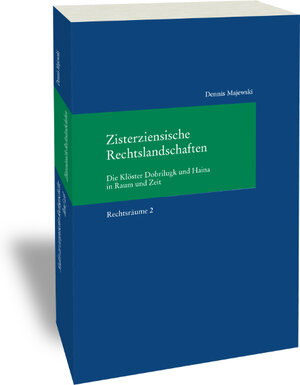Zisterziensische Rechtslandschaften
Die Klöster Dobrilugk und Haina in Raum und Zeit (Rechtsräume 2)
von Dennis MajewskiDer Band entwickelt am Beispiel der Besitzungen und Rechte der Zisterzienserklöster Dobrilugk (heute Doberlug-Kirchhain) und Haina das Konzept der ‚Rechtslandschaft‘. Während Haina im fränkischen Altsiedelland liegt, ist Dobrilugk in der Niederlausitz in einem Gebiet gegründet worden, das erst seit dem 11. Jahrhundert nach und nach mit den Ordnungsmustern des römisch-deutschen Reiches durchdrungen und erschlossen wurde. Durch einen intensiven systematischen und auf Karten gestützten Vergleich wurde aus den Perspektiven ‚Raum‘, ‚Zeit‘ und ‚Akteure‘ herausgearbeitet, wie beide Klöster mit ähnlichem Instrumentarium auf unterschiedliche Bedingungen reagierten, um eine Einflusssphäre auszubauen, für die Begriffe wie Territorium oder Herrschaftsraum keine geeignete Beschreibung darstellen.
Using the example of the possessions and rights of the Cistercian monasteries Dobrilugk (today Doberlug-Kirchhain) and Haina, the volume develops the concept of the ‘Rechtslandschaft’ ('legal landscape'). While Haina is located in the ancient Franconian settlement areas, Dobrilugk was founded in the Lower Lusatia in an area that since the 11th century has only gradually been penetrated and developed by the Roman-German Empire´s patterns of order. Through an intensive systematic comparison also based on maps, the perspectives 'space', 'time' and 'actors' were used to illustrate how both monasteries responded to different conditions with similar instruments in order to expand their spheres of influence which cannot be accurately described by terms such as territory or dominion.
Using the example of the possessions and rights of the Cistercian monasteries Dobrilugk (today Doberlug-Kirchhain) and Haina, the volume develops the concept of the ‘Rechtslandschaft’ ('legal landscape'). While Haina is located in the ancient Franconian settlement areas, Dobrilugk was founded in the Lower Lusatia in an area that since the 11th century has only gradually been penetrated and developed by the Roman-German Empire´s patterns of order. Through an intensive systematic comparison also based on maps, the perspectives 'space', 'time' and 'actors' were used to illustrate how both monasteries responded to different conditions with similar instruments in order to expand their spheres of influence which cannot be accurately described by terms such as territory or dominion.






